Geometry | Term 1 Chapter 4 | 6th Maths - Angles | 6th Maths : Term 1 Unit 4 : Geometry
Chapter: 6th Maths : Term 1 Unit 4 : Geometry
Angles
Angles
Can we find a way to describe all these shapes?
(shown in fig. 4.20)
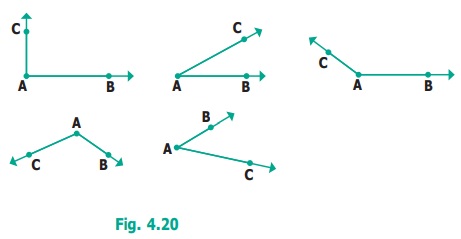
How would you describe whether a ray (or line segment)
is vertical or slanting with respect to another ray (or line segment)?
Note
We can do the same with two line segments
also. See the figures given below.
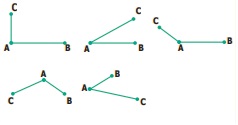
Carrom board involves many geometric concepts like line segments and angles. When
the striker hits the coin, the coin moves in a straight line. When the striker or coins hit the board
end they make angles with the board while returning.

When two rays or line segments meet at their end
points, they form an angle at that point.

In the Fig.4.21 rays  are the sides and ‘A’ is the vertex which is the meeting point of both the line
segments.
are the sides and ‘A’ is the vertex which is the meeting point of both the line
segments.
1.
Naming Angles
We name the angle as shown in the Fig.4.22 below.
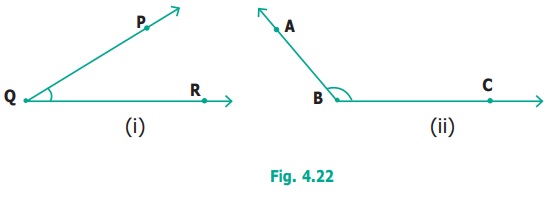
Fig 4.22(i) shows ∠PQR; ![]() ,
, ![]() are its sides.
'P' is on
are its sides.
'P' is on ![]() ; 'R' is on
; 'R' is on ![]() .
.
Fig 4.22(ii) shows ∠ABC; ![]() ,
, ![]() are its sides.
'A' is on
are its sides.
'A' is on ![]() ; 'C' is on
; 'C' is on ![]() .
.
We name the angles in fig. 4.22 (i) as ∠Q or ∠PQR or ∠RQP . Similarly, in
Fig. 4.22 (ii), we may write ∠B as
∠ABC or ∠CBA.
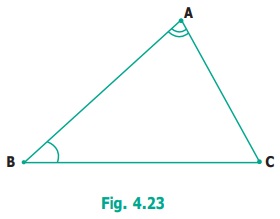
In the Fig. 4.23, two angles are marked.
Note that ∠BAC is not the same as ∠ABC, as they have different vertices and different sides
2.
Measuring Angles
Can we measure angles too? Yes, they are measured
in degrees and denoted by the symbol ‘ º ’. This has to be marked at top right of
a number. We write angles as 35°, 78°, 90°, 110°, 145° and so on.
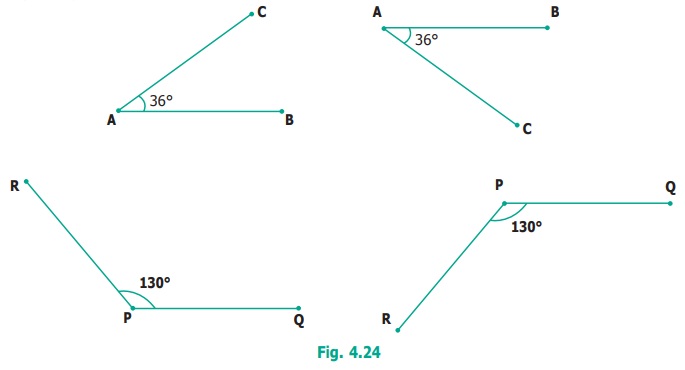
See that angles can be equal even if they are positioned
differently.
3.
Special Angles
Some angles are special. 90° is one such. We call
it as the right angle.
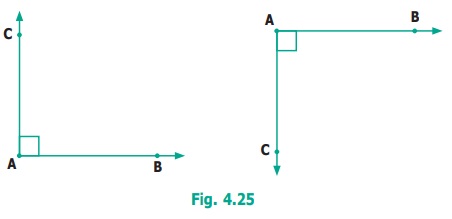
Right angle is most common in life. Examples can
be seen at cross-roads, chess board, TV, etc.
Acute Angles
Each of the angles in the above Fig. 4.26 is less
than a right angle. Angles smaller than 90º are called Acute
angles.

Obtuse Angles
Each of the angles in the above Fig. 4.27 is greater
than right angle. Angles more than 90º are called Obtuse
angles.
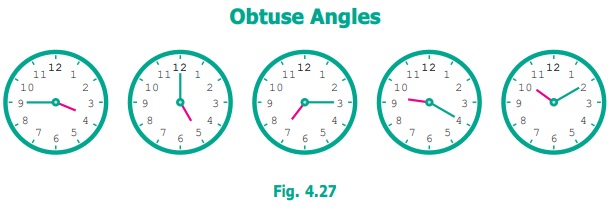
Activity
Stand facing the north side. Take
a ‘right angle turn’ clockwise; you now face east. Again take another ‘right angle
turn’ in the same direction. You now face south. Once again take another ‘right
angle turn’ in the same direction. You now face west. Then follow the same you will
come to the original position. Thus the complete turn is called one revolution.
The turn from north to south will be two right angles. It is also called a straight
angle. Two straight angles make one complete revolution. This is illustrated in
the following figures.

Try these
1. Which
direction will you face if you start facing West and take three right turns clockwise?
Answer: South Direction

2. Which direction will you face if you start facing North and take two right turns anti-clockwise?
Answer: South Direction

Related Topics